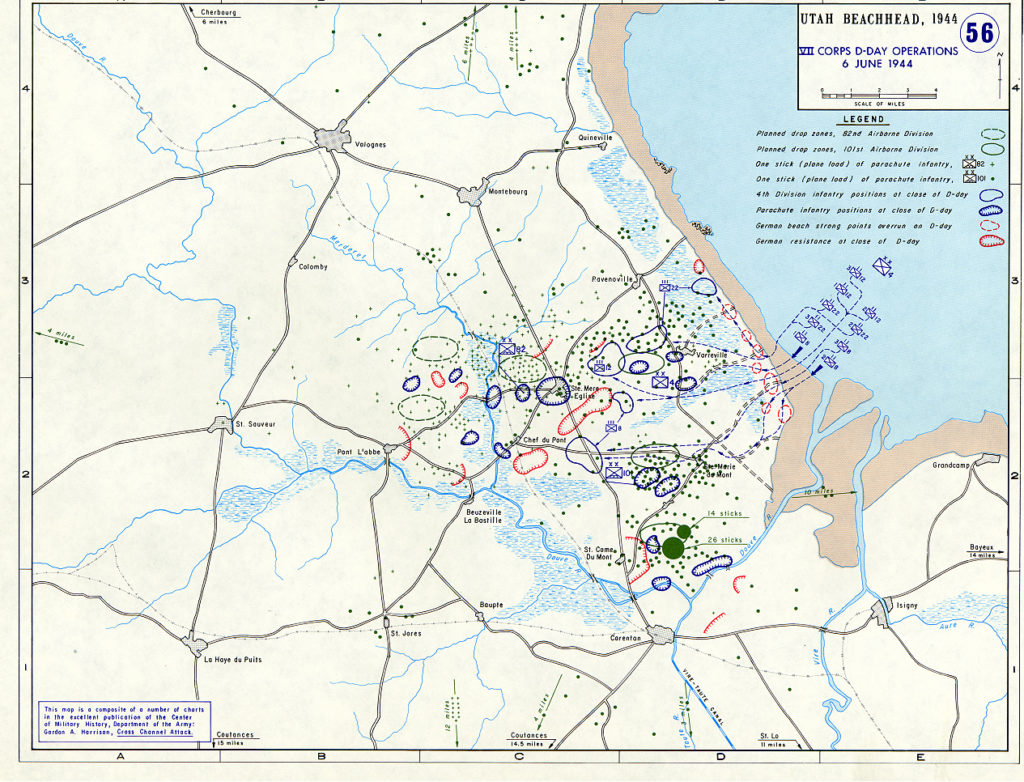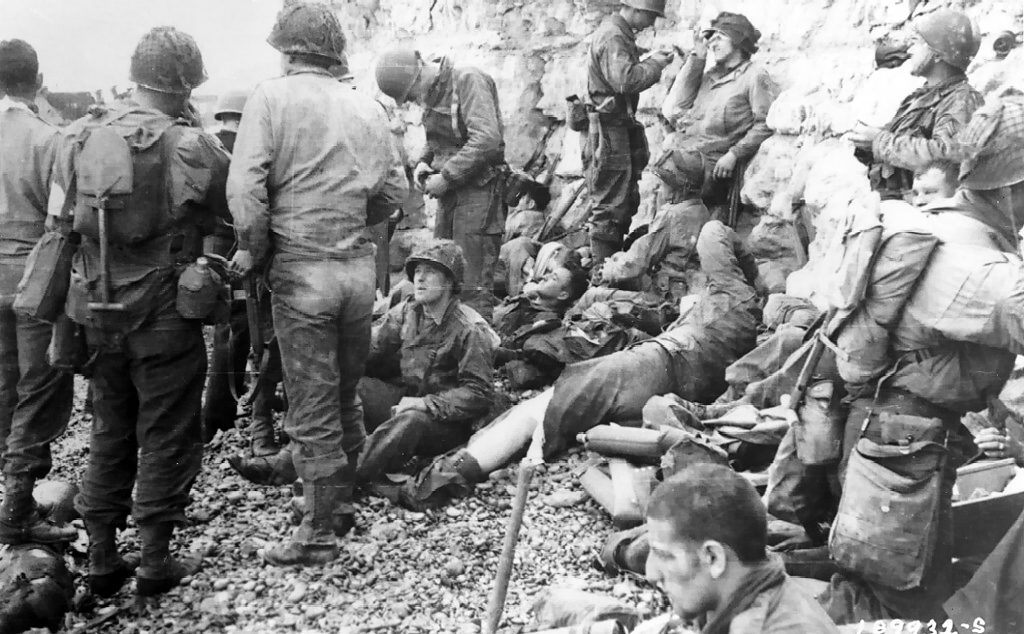The previous post ended with our group’s stop at the German battery at Longue-sur-Mer about eight kilometers west of Arromanches and 16 kilometers east of Omaha Beach. Once we arrive at the latter, we will have passed from the British and Canadian sectors into the American sector. The beaches codenamed Utah and Omaha comprised that sector so I’ll take a brief look at both.
The least deadly beach.
The National D-Day Memorial in Bedford, Virginia has, as I write this, officially recorded 4,413 Allied deaths on June 6, 1944. Most other sources estimate Allied casualties at approximately 10,000 with casualties defined as persons killed, wounded, missing in action or taken prisoner of war. By nationality, those casualties are generally estimated to be 950 Canadians, 2,700 from the UK and 6,600 Americans. And it was at Omaha Beach where the U S soldiers absorbed the greatest number of those.
Of the five major sectors, the fewest casualties came on Utah – the other American beach. The official casualty count for the infantry assault on Utah Beach is reported as 197 with 60 of those reported as missing. However, the likely reason that number is by far the lowest of the five beach sectors is the result of the work and sacrifice of more than 13,000 American paratroopers from the 101st and 82nd Airborne Divisions who began their work neutralizing German defenses some six hours before H-Hour. The casualties in these units exceeded 2,500.
Utah Beach wasn’t included in the original plans for Operation Overlord (the code name for the plan to retake Europe) but was added by Generals Dwight Eisenhower and Bernard Montgomery after they saw the initial plans. It entailed expanding the necessary forces from three amphibious divisions and half an airborne division to five amphibious and three airborne divisions.
[Map from United States Military Academy Department of History – Public Domain.]
There was a twofold objective for widening the scale of the invasion (from approximately 40 kilometers to nearly 80) and for making the landing at this point on the Cotentin Peninsula. Widening the scale would, in theory, make it more difficult for the Germans to respond. Second, by landing on this beach, though it was separated from the other landing beaches by the double river mouth of the rivers Douvre and Vire and by Pointe-du-Hoc (the latter would be assaulted by three companies of the 2nd Ranger Battalion and their efforts would prove crucial to the success at Omaha), the Allies hoped to accelerate the capture of the port at Cherbourg.
And then there was Omaha.
This photograph by Robert F Sargent is known as Into the Jaws of Death.
The amphibious landings began at 06:30 and the photo above was taken at 07:40. Already, the situation for the American troops had become desperate and it had started in the darkest hours of what came to be called “The Longest Day.”
Allied intelligence knew that in addition to the natural bluffs and cliffs overlooking the beach, this was the most heavily fortified and well defended area of the five sectors. A pre-attack count estimated some 7,800 German troops, 85 machine gun sites, 45 rocket launcher sites, 35 pillboxes, 18 anti-tank guns, 8 artillery bunkers, 6 tank turrets, and 4 pieces of major artillery. But one key piece of intelligence that the French Resistance had learned just the day before the attack was missing and the American forces would pay dearly.
An hour before the 06:30 landing time, the Allies began an air assault on the German positions atop the bluffs and cliffs looming above the stretch of beach once known as la Cote d’or (The Golden Coast). Shortly thereafter they also began attacking with naval artillery. Heavy fog and low clouds caused the bombers to miss their targets and, in some instances, to set the countryside ablaze. The smoke (which you can see in Sargent’s photo) further obscured and hindered the naval targeting as well. The German defenses remained mainly intact.
Meanwhile, the weather was also taking its toll on the amphibious force. Ten of the landing craft and several tanks sank before they reached the beach. The water was so choppy that seasickness was pervasive. The smoke and mist obscured the landmarks the troops were supposed to use to guide them to the correct sector of the beach and the natural flow of the tide pushed the boats toward the east taking them away from their designated landing areas.
Those who did reach the shore had to cross nearly 500 meters of open beach before they reached any cover. And it was in trying to cross that half kilometer that the soldiers began to pay the price for the inaccurate intelligence. The Allies believed the defenses were manned by the 716th Infantry Division which was comprised largely of Russian “volunteers” and German Volksdeutsche. However, the Germans had replaced that unit with the 352nd Infantry Division – a hardened group of professional soldiers who had been preparing for an assault since March.
They were a key part of Rommel’s plan to defend the coast. He believed that Germany would inevitably be defeated unless the invasion could be stopped on the beach, declaring, “It is absolutely necessary that we push the British and Americans back from the beaches. Afterwards it will be too late; the first 24 hours of the invasion will be decisive.”
Though Hitler hadn’t fully committed to Rommel’s strategy, it appeared to be working at Omaha Beach. U S infantrymen in the initial waves of the attack were gunned down in massive numbers by German machine-gun fire. Officers, too, were killed and when that was coupled with the disorientation from missing their landing targets, the situation disintegrated into chaos. The carnage became so severe that General Bradley considered abandoning the entire operation. He chose instead to send additional units. Slowly but surely, perhaps by force of sheer numbers, units began making it across the beach to the relative safety of the seawall at the foot of the bluffs and then up the bluffs themselves.
[Photo of American troops after the second wave – Wikimedia – Public Domain.]
Aided by the success of the Ranger Company at Pointe-du-Hoc, dedicated local leadership, and some remarkable acts of heroism by the troops, the American forces established a tenuous toe hold of about two kilometers by midnight. Over 30,000 American men landed on Omaha beach that day. Total casualties numbered exceeded 2,400.
(If you’re interested in a more detailed history of what happened at Omaha Beach on 6 June 1944, particularly the story of Lieutenant Walter Taylor who was one of the great heroes of that day, I highly recommend this recounting by S L A Marshall for the November 1960 issue of the Atlantic Monthly.)
Note: In keeping with my 2022-2023 reformation of the blog into shorter entries, backdated to maintain their sequence, any comments on this post might pertain to its new configuration. See the full explanation in the post Conventions and Conversions.



I was age 10 when D-Day occurred, so not really aware of the gravity of then-current events. Reading your compilations brings home the enormity of what our
predecessors accomplished. I’m not sure successor generations would have been blessed with the same success.
Keep up the good work.
Thank you. I appreciate your thoughtful response.
You missed the German Grave Site. Also impressive but dark and gloomy. Very gothic.
I guess you’re referring to the cemetery at La Cambe and from photos, it looks quite interesting. Unfortunately, it’s not quite 20 kilometers east of the American Cemetery and one of the drawbacks of tours like this one – especially with groups this large is that the schedules are often rigid tightly managed. This wasn’t on the itinerary so there was no chance we’d see it. Maybe if I get back there on my own. (The truth is that even if it had been, I’m not sure I would have wanted to spend any more time with that guide than absolutely necessary.)